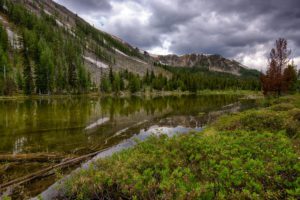May 15, 2023
Contacts:
Jonathan Ratner, (877) 746-3628, Western Watersheds Project; jonathan@westernwatersheds.org
John Carter, (435) 881-5404, Yellowstone to Uintas Connection; jcoyote23@gmail.com
A report just released by Western Watersheds Project (WWP) and Yellowstone to Uintas Connection (Y2U) documents habitat degradation by livestock in Wyoming’s Upper Green River Basin, a major wildlife area in the Greater Yellowstone Ecosystem.
A decision by the US Forest Service in 2019 authorized over 17,000 cattle to graze 170,643 acres of suitable grizzly bear habitat here. Ninety-six percent of the area is designated as wildlife emphasis in the Forest Plan. Fifty-two percent of the 27 grizzly bear deaths in western
Wyoming between 2010 and 2014 took place in the project area, with an additional 18 bears relocated. All were due to conflicts with cattle. The decision provided for these cattle to graze the area for four months each summer for ten years. That decision is being litigated by WWP, Y2U and others for failure to provide protections for grizzly bears and apply scientific management and standards to livestock management.
“I have monitored its condition for two decades,” said Jonathan Ratner, Wyoming Director for Western Watersheds Project. “The Forest Service dismisses public input and assessments of the failures in their monitoring and management programs. Streams and habitats are degraded, native fish are declining, and bears are being killed. It’s tragic. And to make matters worse, nearly all of the area is zoned in the Forest Plan for the protection of wildlife.”
A number of livestock grazing allotments in the Elk Ridge Complex have been bought out for conservation purposes, and have been livestock-free for five years, but the Forest Service is currently considering re-stocking them with livestock. The report finds that these allotments remain in poor condition as a result of past heavy livestock use, providing inadequate habitat for sage grouse, elk, mule deer, and other native species.
“Conservationists bought out over 30,000 acres of grazing allotments in the Elk Ridge Complex to improve habitats and solve conflicts between livestock and grizzly bears, wolves, and bighorn sheep, but now the Forest Service is threatening to go back on its word and bring the livestock – and the impacts and conflicts they cause – back,” said Ratner. “This new report demonstrates that five years of rest from livestock is nowhere near adequate to restore damaged habitats, and makes a compelling case that the standard livestock grazing levels authorized by the Forest Service are far too heavy to prevent major habitat damage.”
Grizzly bears are classified as a threatened species under the Endangered Species Act. They rely on a variety of foods, including whitebark pine seeds, plants, insects, roots, and animal carcasses. Whitebark pines have suffered major mortality due to climate-related insect outbreaks and are mostly gone now. The loss of this important food source increases the bears’ need for other foods.
“The Forest Service is currently planning to log and remove nearly 6,000 acres of whitebark pines and other conifers here, which will greatly reduce the security cover for the bears,” said Dr. John Carter, Ecologist with the Yellowstone to Uintas Connection. “This habitat and food loss for the bears is added to by the killing and removal of bears due to conflicts with livestock. ESA-listed species are being killed to protect private livestock on our public lands.”
The report describes the degraded condition of this area due to livestock grazing. It determines that the Forest Service does not follow the long-standing science on how to manage livestock grazing. It documents a significant decline in the forage plants that should be present. The livestock producers that rely on this forage base may be unaware that grazing management has contributed to the loss of forage production. This is due to overstocking of livestock, not allowing plant communities to recover from grazing, and a monitoring program that is unable to detect the use by livestock.
To correct the problem, the livestock stocking rate would need to be reduced by about two thirds from present numbers. Management would change to reflect what leading range scientists have recommended for decades in order for the grazing by livestock to be sustainable and also provide for bears, fish, amphibians, migrant birds, and other wildlife.
“We see this same situation across the west no matter where we conduct monitoring studies and the damage is clearly observable in every case,” said Dr. Carter, Ecologist with the Yellowstone to Uintas Connection. “Agency denial and deflection around the causes of the habitat degradation are universal and like the 2019 Upper Green Rangeland Decision, they put band aids on the problem while failing to address the underlying causes, thus perpetuating and increasing the damage while our wildlife and water supplies suffer.”






